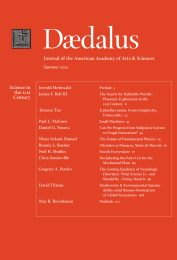The Coming Epidemic of Neurologic Disorders: What Science Is - and Should Be - Doing About It
The Earth’s population is aging fast, and the coming sharp increase in the number of people over age sixty-five will bring with it an epidemic of age-related neurodegenerative diseases, such as Alzheimer’s and Parkinson’s diseases. Currently, no cures exist for the major neurologic disorders. Unless cures can be found, by 2050 the cost of these diseases will exceed $1 trillion annually in the United States, and the burden for other countries will scale with their populations. Despite exciting advances in our understanding of these diseases, both government research funding and the efforts of industry have failed to keep pace with this unmet medical need. Private philanthropy has done better, but the total dollars spent on developing diagnostics and therapeutics for neurologic disorders still lags far behind that spent on much less prevalent diseases. The challenge for biomedical research in the next forty years is to identify markers that would allow early detection of high-risk cohorts, and to develop therapies that either will prevent the diseases from starting at all in susceptible populations or will arrest their progression before severe damage to the central nervous system has occurred.
What would you think if you were told that the entire population of the four largest cities in the United States had suddenly come down with an incurable, fatal disease? You would probably suspect a terrorist biowarfare attack or else the emergence of some horrible new strain of bird flu or Ebola-like virus. Barring a medical miracle, something very like that is certain to happen in about forty years’ time. By 2050, the United States is predicted to have thirty-two million people over the age of eighty, and unless something is done to prevent it, about sixteen million of them will have Alzheimer’s disease. That’s more than the populations of New York, Los Angeles, Chicago, and Houston put together.
The United States is not alone in this explosion of the elderly and potentially infirm. Throughout the world today, there are more people aged sixty-five and older than the entire populations of Russia, Japan, France, Germany, and Australia–combined. That seems like a lot, but it is minuscule compared with what is coming. From 1950 to 2050, the world population will have increased by a factor of 3.6; but those sixty and older will have increased by a factor of 10, and those eighty and older will rise by a factor of 27.
. . .
